Charles-Édouard Jeanneret, better known as Le Corbusier, was a multitalented creative figure who brought very different disciplines together, making them engage in a dialogue, while maintaining an intense and rich discursive character that was important to the world of art in general and architecture in particular. He was an architect, planner, inventor, designer, philosopher, writer, poet, activist, polemicist, developer and also a painter.
This exhibition looks at his pictorial work and aims not only to analyse its main characteristics but also to raise awareness of its importance, as drawing and painting were both major aspects of his professional career.
"The ethical search for hygiene, the extolling of the purity of engineering, the celebration of the straight lines and the white factories lauded by Le Corbusier instigated the modern narrative of 20th-century architecture, which asserted that man is fundamentally a clean body with universal needs that were summed up thus by Le Corbusier: 'Tout homme sait aujourd’hui qu’il lui faut du soleil, de la chaleur, de l’air pur et des parquets propres'.[1]
The representation of this universal man led to long and continual plastic research by Le Corbusier from the late 1920s onwards, culminating eventually in the Modulor in 1948. The human figure made its first appearance in his paintings in 1918, but in the 1930s, following his trips to South America and Algeria, it became the central theme of his plastic works, particularly the female figure, which was the essential focus of his artistic oeuvre." (Marisa García Vergara)
[1] Le Corbusier, Vers une architecture, Paris, Ed. G. Crès et Cie, 1924, p. 234.
Marc Domènech surrenders to the painting of Le Corbusier
Le Corbusier, the architect painter, at Marc Domènech













